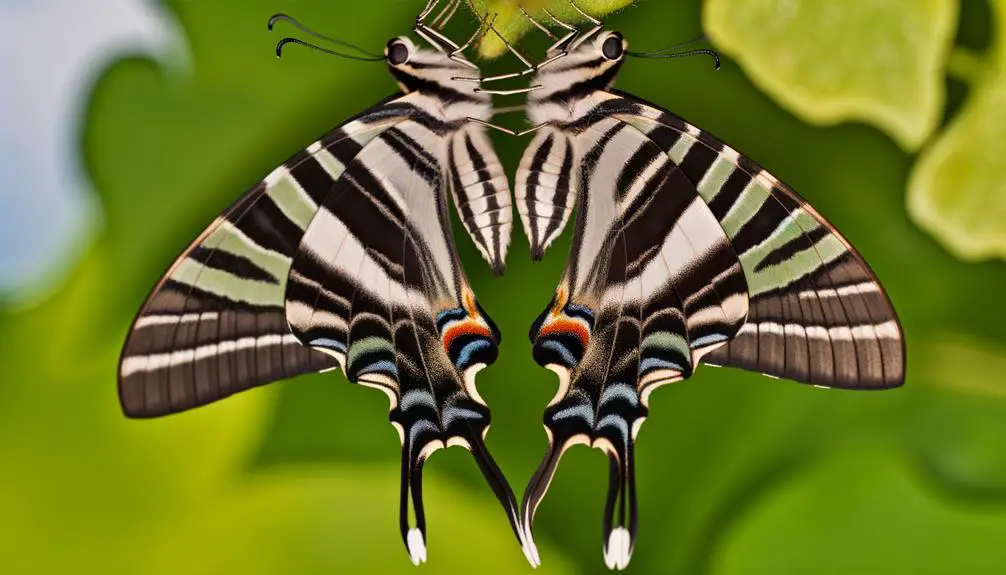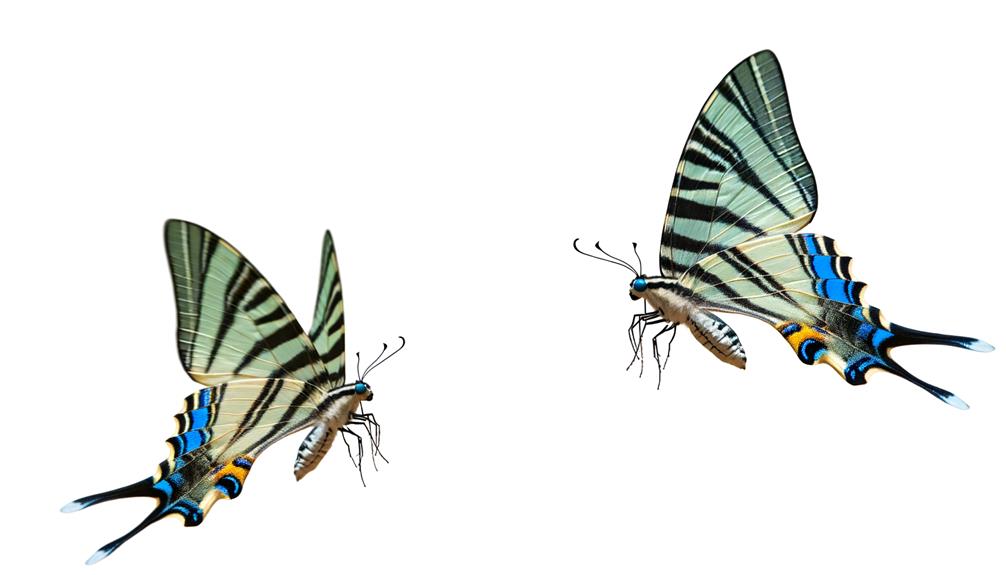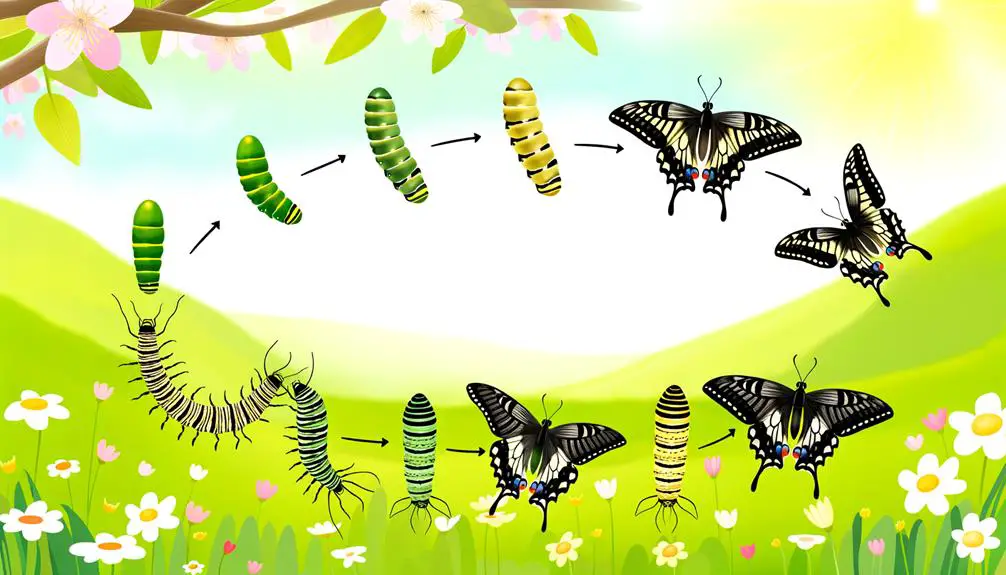7 Key Differences in Male vs Female Zebra Swallowtail Butterflies
The Zebra Swallowtail Butterfly demonstrates marked sexual dimorphism. Males feature pronounced black and white stripes, elongated forewings and hindwings, and robust antennae for enhanced pheromone detection, partaking in rapid, erratic flight patterns for territory defense and mating pursuits.
Females exhibit subtler coloration with blue and iridescent hues, larger body sizes due to reproductive roles, and streamlined antennae tailored for navigation and oviposition. Females have a deliberate flight mode focused on host plant detection.
These differences underscore distinct ecological roles and behaviors of males and females. To grasp thorough insights on their biomechanics and lifecycle, further exploration is essential.

Key Takeaways
- Males have pronounced black and white striping for courtship, while females' subtler hues aid camouflage during egg-laying.
- Males exhibit rapid, erratic flight for territory and mate searching; females fly more deliberately to find host plants.
- Male antennae are longer and denser with sensilla for detecting pheromones; females have streamlined antennae for better navigation.
- Males defend territories around pawpaw trees and nectar sources; females focus on locating optimal egg-laying sites.
Physical Appearance

The physical appearance of the Zebra Swallowtail Butterfly (Eurytides marcellus) exhibits distinct sexual dimorphism, with notable differences between males and females in wing coloration, size, and patterning.
Males typically possess more elongated forewings and hindwings compared to females, facilitating a swifter flight capability. Additionally, males often display more prominent black and white striping, contributing to heightened visibility during courtship displays.
Females, on the other hand, are generally larger in body size, which is an adaptation for increased fecundity. The coloration in females tends to be slightly more subdued, potentially serving as camouflage during oviposition.
These morphological differences are essential for their respective reproductive strategies and ecological roles, underscoring the evolutionary pressures shaping their development.
Wing Patterns
Examining the wing patterns of the Zebra Swallowtail Butterfly reveals intricate differences that further distinguish males from females, reflecting their unique ecological and reproductive roles. Males typically have longer tails and more pronounced black striping, which aids in swift maneuvering during mate selection and territorial displays. In contrast, females often exhibit broader wing shapes with slightly muted coloration, enhancing their camouflage while laying eggs. These male vs female swallowtail differences highlight the evolutionary adaptations that optimize their survival and reproductive success in diverse habitats.
Males typically exhibit more pronounced black and white striping, with a higher contrast that aids in territorial displays and mate attraction. Their elongated tails are more distinctly marked, enhancing visual signaling during flight.
Females, on the other hand, possess subtler striping with additional blue and iridescent hues on the hindwings, likely serving as camouflage during oviposition. The forewings of females often show broader white bands, contributing to their less conspicuous appearance.
These morphological variations in wing patterns are critical for their respective survival strategies, ensuring effective communication and reproductive success in their natural habitats.
Body Size

Intriguingly, sexual dimorphism in body size among Zebra Swallowtail Butterflies demonstrates significant differences, with females generally exhibiting larger and more robust physiques compared to their male counterparts.
The average wingspan of female Zebra Swallowtails (Eurytides marcellus) ranges from 68 to 102 millimeters, while males typically measure between 63 and 100 millimeters. This size disparity is attributed to the females' reproductive role, necessitating a larger abdomen to accommodate egg production.
Morphological measurements indicate that females possess more substantial thoracic musculature, enhancing their capacity for sustained flight during oviposition. Conversely, males exhibit more streamlined bodies, optimizing agility and maneuverability for mate pursuit and territorial defense.
This sexual dimorphism underscores evolutionary adaptations aligned with their distinct ecological and reproductive roles.
Antennae Differences
Differences in the antennae of male and female Zebra Swallowtail Butterflies reveal subtle yet significant variations in morphology and sensory function.
Male antennae, often slightly longer and more robust, exhibit a greater density of sensilla—microscopic sensory structures—enhancing their ability to detect female pheromones over greater distances. This adaptation is essential for locating potential mates in expansive habitats.
Conversely, female antennae, while also equipped with sensilla, display a more streamlined morphology, possibly reflecting a greater emphasis on navigation and oviposition site selection.
The disparity in antennae structure between sexes underscores the evolutionary pressures that shape sensory capabilities, optimizing each gender for its reproductive and ecological roles.
These morphological nuances offer insight into the complex interplay of form and function in Lepidoptera.
Flight Behavior

Beyond the morphological distinctions in their antennae, the flight behavior of male and female Zebra Swallowtail Butterflies also exhibits notable differences tailored to their respective ecological roles.
Males exhibit more erratic and rapid flight patterns, often engaging in prolonged aerial pursuits. This behavior is hypothesized to facilitate territory establishment and patrolling for potential mates.
In contrast, females demonstrate a more measured and deliberate flight, primarily focused on locating suitable host plants for oviposition. Their flight paths tend to be lower and more linear, optimizing their efficiency in host plant detection.
These behavioral disparities underscore the evolutionary adaptations of each sex to their reproductive and survival strategies, ensuring the species' ecological success and propagation.
Mating Rituals
The mating rituals of Zebra Swallowtail Butterflies involve a series of intricate behaviors and environmental cues that promote successful copulation.
Males utilize their acute olfactory and visual senses to locate potential mates, often congregating in areas abundant with nectar sources. Upon encountering a receptive female, the male engages in a courtship display characterized by a distinctive flight pattern and pheromone release. This behavior communicates his fitness and readiness to mate.
Females, in turn, assess the male's vigor and genetic quality through these cues before consenting. Copulation occurs when the female extends her abdomen to receive the male's spermatophore, a nutrient-rich packet enhancing reproductive success.
These precise interactions promote genetic diversity and species propagation.
Territorial Habits

In their quest for ideal mating and foraging opportunities, Zebra Swallowtail butterflies exhibit pronounced territorial behaviors, with males actively defending specific areas abundant in essential resources.
Males establish and patrol territories near prime host plants, primarily pawpaw trees (Asimina spp.), essential for larval development. Territorial disputes are frequent, involving aerial chases and displays of dominance to deter intruding males.
These territories enhance mating success by attracting females seeking suitable oviposition sites. Females exhibit less territoriality, focusing instead on locating prime sites for egg-laying.
This sex-specific behavior underscores the evolutionary strategies aimed at maximizing reproductive success. The dynamic interplay of territoriality in males and the selective behavior in females exemplifies the adaptive mechanisms governing Zebra Swallowtail butterfly population dynamics.
Feeding Preferences
The feeding preferences of male and female Zebra Swallowtail butterflies exhibit distinct patterns, with males primarily sourcing nectar from specific flowering plants, while females demonstrate a broader range of nectar sources.
Observational studies indicate that males frequently visit plants such as milkweed and verbena, whereas females utilize a variety of floral species for nectar.
These variations in feeding behavior are critical in understanding the ecological roles and energetic strategies of each sex within their habitats.
Nectar Source Differences
Frequently, male and female Zebra Swallowtail butterflies exhibit distinct preferences in nectar sources, a difference that can be attributed to their varying energy requirements and reproductive roles.
Males, primarily driven by the need for sustained energy during mate-seeking activities, often favor high-energy nectar sources. Conversely, females prioritize nectar sources that provide a steady nutrient supply necessary for egg production and oviposition.
- Males tend to visit flowers from the Apocynaceae family, known for high nectar production.
- Females are observed to frequent plants like Asclepias species, which offer nutrient-rich nectar.
These preferences highlight the intricate interplay between physiology and behavior in the Zebra Swallowtail's feeding ecology.
Feeding Behavior Patterns
Observations indicate that Zebra Swallowtail butterflies exhibit distinct feeding preferences that reflect their physiological needs and ecological roles.
Males primarily engage in mud-puddling behavior, extracting vital minerals and sodium from moist substrates. This activity supports their reproductive success by enhancing their spermatophore production.
Conversely, females mainly focus on nectaring from a diverse array of floral sources, maximizing their caloric intake to fuel oviposition processes. Specific floral preferences include species with long corolla tubes, which accommodate their proboscis morphology.
Both sexes show an affinity for Pawpaw (Asimina triloba) flowers, essential for larval sustenance.
These feeding patterns are not only vital for individual fitness but also guarantee the perpetuation of the species across their habitat range.
Life Cycle

The life cycle of the Zebra Swallowtail Butterfly (Eurytides marcellus) encompasses four distinct developmental stages: egg, caterpillar (larva), pupa (chrysalis), and adult.
During the larval stage, significant morphological changes occur as the caterpillar undergoes multiple instars before pupation.
The shift from pupa to adult involves metamorphosis, leading to the emergence of sexually dimorphic butterflies, with males and females exhibiting differences in wing patterns and behaviors critical for mating and survival.
Egg to Caterpillar
During the initial stage of the Zebra Swallowtail Butterfly's life cycle, the female deposits her eggs singularly on the leaves of pawpaw trees (Asimina spp.), guaranteeing a suitable environment for the emerging larvae. This strategic choice is vital, as pawpaw leaves contain compounds that deter many potential predators.
Upon hatching, the larvae, or caterpillars, exhibit specific adaptive behaviors and physiological traits to optimize their growth and survival.
- Feeding Habits: Caterpillars consume pawpaw leaves, gaining both nutrients and chemical defenses.
- Camouflage: The larvae display coloration that mimics their surroundings, reducing predation risks.
These stages are meticulously designed to guarantee successful development into the next phase.
Pupa to Adult
Upon entering the pupal stage, Zebra Swallowtail Butterfly larvae undergo a complex metamorphosis within a chrysalis, transforming their internal and external structures to emerge as fully developed adults.
During this period, the larval tissues are systematically broken down and reconstituted into adult forms. The imaginal discs, clusters of undifferentiated cells, proliferate and differentiate into wing, antenna, and leg structures.
Hemolymph circulation facilitates the distribution of nutrients and hormones essential for development. Ecdysteroids and juvenile hormones regulate the timing and coordination of this intricate process.
In about 10 to 14 days, the pupal case darkens, signaling imminent emergence. The adult butterfly, or imago, then ecloses, completing its metamorphosis and ready to commence its reproductive phase.
Habitat Roles
Both male and female Zebra Swallowtail butterflies exhibit distinct roles within their respective habitats, contributing to the ecological balance and species propagation.
Males mainly engage in patrolling behaviors, actively searching for receptive females, thereby guaranteeing successful mating.
Females, on the other hand, are critical in oviposition, selecting specific host plants like pawpaw (Asimina triloba) for egg-laying, which secures larval survival and growth.
Notable habitat roles include:
- Pollination: Both sexes contribute to the pollination of various flowering plants.
- Territoriality: Males establish and defend territories, enhancing reproductive success.
These behaviors underscore the species' integral ecological functions, fostering biodiversity and sustaining their populations.
Conclusion
The distinctions between male and female zebra swallowtail butterflies encompass various aspects, including physical appearance, wing patterns, body size, antennae differences, flight behavior, territorial habits, feeding preferences, and life cycle.
How do these morphological and behavioral variations contribute to their ecological roles and reproductive success?
By examining these characteristics, one can better understand the adaptive strategies that facilitate the survival and propagation of the species within its natural habitat.






